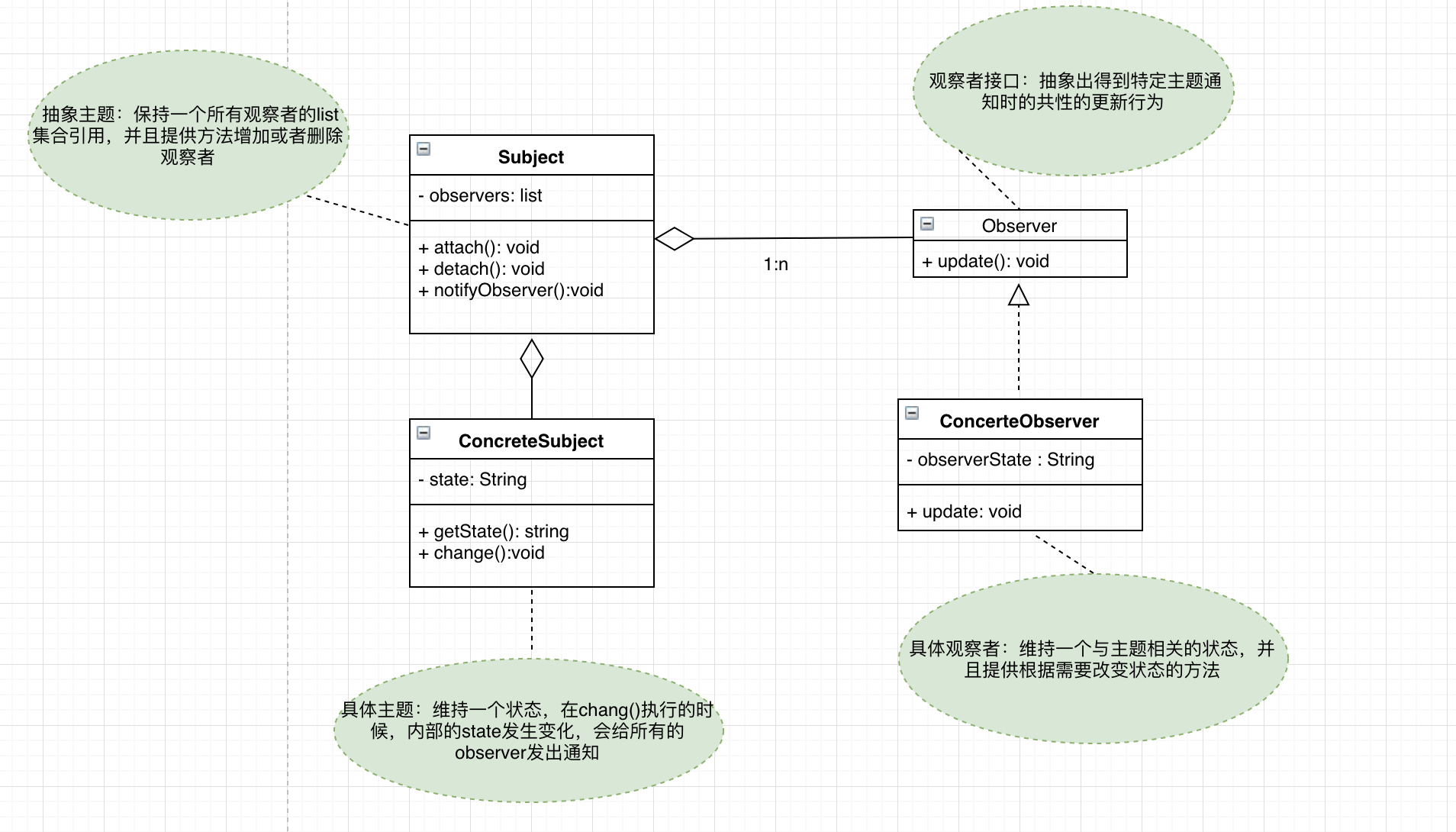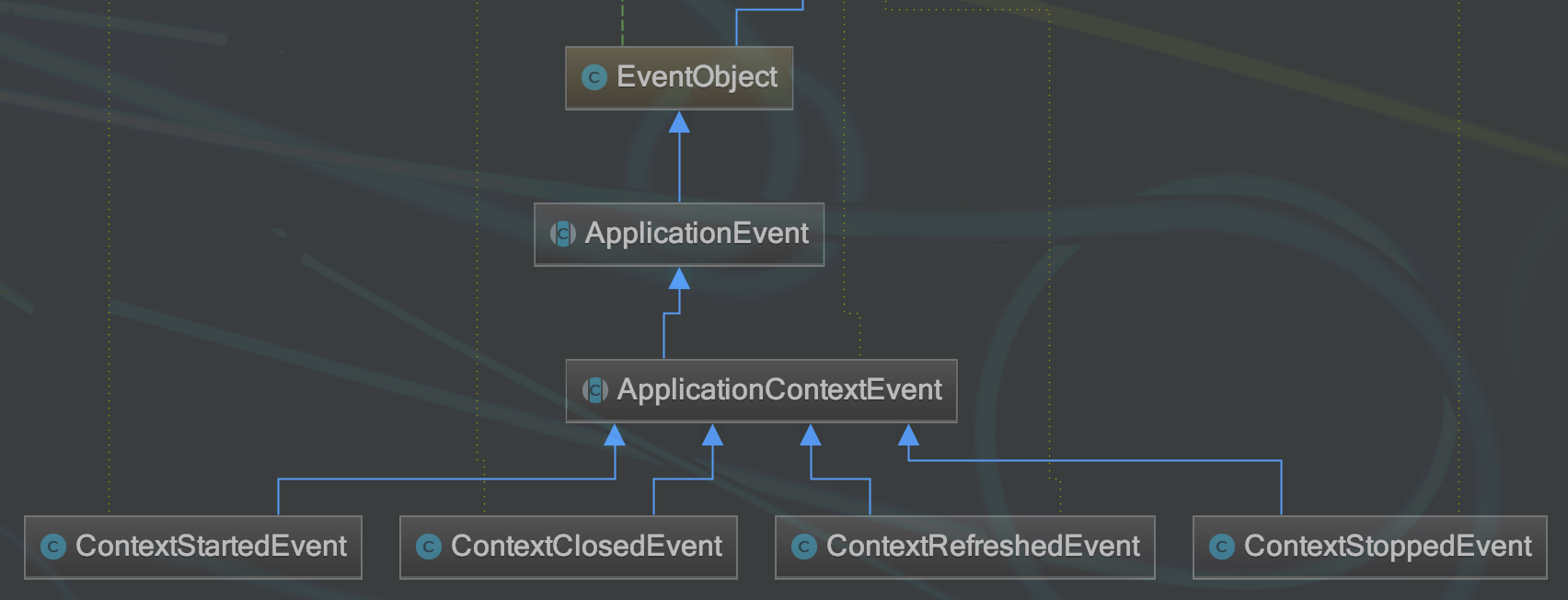Spring的事件监听机制
最近公司在重构广告系统,其中核心的打包功能由广告系统调用,即对apk打包的调用和打包完成之后的回调,需要提供相应的接口给广告系统。因此,为了将apk打包的核心流程和对接广告系统的业务解耦,利用了spring的事件监听特性来满足需求。以下说明spring的事件机制的相关内容。
1.观察者模式
Spring的事件监听(也称事件驱动)是观察者模式的一种实现,比较常见的有发布-订阅模型。通常我们利用消息队列来实现不同系统之间的解耦,如用户注册完成后,可以向消息队列发布一条消息,然后订阅了此topic的子系统(如邮件服务,积分服务)收到发布的消息之后,就会做相应的处理。这样做的好处是避免了在注册服务里耦合其他服务的代码,并且,执行子系统的业务将会异步执行,互不影响。下图是一个经典的观察者模式的结构。

以下为上述观察者模式的java简单实现:
(1)Subject.java
1 package observerPattern; 2 3 import java.util.ArrayList; 4 import java.util.List; 5 6 /** 7 * Created by jy on 2018/11/28. 8 */ 9 public abstract class Subject { 10 11 //维护一个所有观察者集合 12 private List<Observer> list = new ArrayList<>(); 13 14 //新注册一个观察者 15 public void attach(Observer observer){ 16 list.add(observer); 17 System.out.println("新注册一个观察者"); 18 } 19 20 //删除一个已注册的观察者 21 public void detach(Observer observer){ 22 list.remove(observer); 23 System.out.println("删除一个已注册的观察者"); 24 } 25 26 27 //通知所有已经注册的观察者 28 public void notifyObservers(String state){ 29 for (int i = 0; i < list.size(); i++) { 30 list.get(i).update(state); 31 } 32 } 33 }
(2)Observer.java
1 package observerPattern; 2 3 /** 4 * Created by jy on 2018/11/28. 5 */ 6 public interface Observer { 7 8 // 抽象出的更新行为 9 public void update(String state); 10 }
(3)ConcreteSubject.java
1 package observerPattern; 2 3 /** 4 * Created by jy on 2018/11/28. 5 */ 6 public class ConcreteSubject extends Subject{ 7 8 //真实主题内维护一个状态 9 private String state; 10 11 public String getState() { 12 return state; 13 } 14 15 public void change(String state){ 16 this.state = state; 17 System.out.println("真实主题状态变化为:"+state); 18 this.notifyObservers(state); 19 } 20 }
(4)ConcreteObserver.java
1 package observerPattern; 2 3 /** 4 * Created by jy on 2018/11/28. 5 */ 6 public class ConcreteObserver implements Observer { 7 8 //具体观察者的状态 9 private String observerState; 10 11 @Override 12 public void update(String state) { 13 //这里可以根据传递过来的主题的状态作出相应的业务 14 observerState = state; 15 System.out.println("观察者的状态跟着变化为:"+observerState); 16 } 17 }
(5)Main.java
1 package observerPattern; 2 3 /** 4 * Created by jy on 2018/11/28. 5 */ 6 public class Main { 7 public static void main(String[] args) { 8 //真实主题 9 ConcreteSubject concreteSubject = new ConcreteSubject(); 10 //真实观察者 11 ConcreteObserver concreteObserver = new ConcreteObserver(); 12 //观察者先注册 13 concreteSubject.attach(concreteObserver); 14 15 //改变真实主题状态 16 concreteSubject.change("2"); 17 18 } 19 }
结果:在执行了main方法之后,我们可以看到控制台输出结果,表明,真实观察者的状态是会根据真实主题的状态变化而变化的:

2. Spring事件监听
spring也对事件驱动模型提供了支持,该模型主要由三部分组成:
(1) 事件(ApplicationEvent):继承了jdk的EventObject,在spring项目中可以继承ApplicationEvent,来自定义自己的事件。
spring容器内部对ApplicationEvent有着下面几个实现,通过名字可以很清楚事件所描述的行为。

(2)发布者(ApplicationEventPublisher):实现这个接口,就可以使得spring组件有发布事件的能力。
可以看到,ApplicationContext实现了此接口,因此,可以spring组件可以通过实现ApplicationContextAware接口,注入ApplicationContext,然后,通过ApplicationContext的publishEvent()方法来实现事件传播,
当然,也可以直接实现ApplicationEventPublisher接口,重写publishEvent()方法,同样可以实现事件传播。

通过阅读源码发现,在AbstractApplicationContext类中,定义了针对观察者的增加,get,注册等方法。下面代码中的addApplicationListener()是向ApplicationEventMulticaster类中维护的一个set中添加listener。这个set存储了该发布者所有的观察者(listener)。
1 @Override 2 public void addApplicationListener(ApplicationListener<?> listener) { 3 Assert.notNull(listener, "ApplicationListener must not be null"); 4 //listener传入持有的一个的applicationEventMulticaster类中 5 if (this.applicationEventMulticaster != null) { 6 this.applicationEventMulticaster.addApplicationListener(listener); 7 } 8 this.applicationListeners.add(listener); 9 } 10 11 //省略部分代码 12 13 protected void registerListeners() { 14 // Register statically specified listeners first. 15 for (ApplicationListener<?> listener : getApplicationListeners()) { 16 getApplicationEventMulticaster().addApplicationListener(listener); 17 } 18 19 // Do not initialize FactoryBeans here: We need to leave all regular beans 20 // uninitialized to let post-processors apply to them! 21 String[] listenerBeanNames = getBeanNamesForType(ApplicationListener.class, true, false); 22 for (String listenerBeanName : listenerBeanNames) { 23 getApplicationEventMulticaster().addApplicationListenerBean(listenerBeanName); 24 } 25 26 // Publish early application events now that we finally have a multicaster... 27 Set<ApplicationEvent> earlyEventsToProcess = this.earlyApplicationEvents; 28 this.earlyApplicationEvents = null; 29 if (earlyEventsToProcess != null) { 30 for (ApplicationEvent earlyEvent : earlyEventsToProcess) { 31 getApplicationEventMulticaster().multicastEvent(earlyEvent); 32 } 33 } 34 }
在AbstractApplicationContext中publishEvent:
1 protected void publishEvent(Object event, @Nullable ResolvableType eventType) { 2 //..... 3 // Multicast right now if possible - or lazily once the multicaster is initialized 4 if (this.earlyApplicationEvents != null) { 5 this.earlyApplicationEvents.add(applicationEvent); 6 } 7 else { 8 getApplicationEventMulticaster().multicastEvent(applicationEvent, eventType); //事件广播
10 //.... 11 }
具体的发布事件的方法都在上面提到的ApplicationEventMulticaster这个类型的类中去实现的,在AbstractApplicationContext中,会先尝试从ConfigurableListableBeanFactory中去加载这个类,如果不存在,则会默认new 一个SimpleApplicationEventMulticaster:
1 protected void initApplicationEventMulticaster() { 2 ConfigurableListableBeanFactory beanFactory = getBeanFactory(); 3 if (beanFactory.containsLocalBean(APPLICATION_EVENT_MULTICASTER_BEAN_NAME)) { //尝试加载 4 this.applicationEventMulticaster = 5 beanFactory.getBean(APPLICATION_EVENT_MULTICASTER_BEAN_NAME, ApplicationEventMulticaster.class); 6 if (logger.isTraceEnabled()) { 7 logger.trace("Using ApplicationEventMulticaster [" + this.applicationEventMulticaster + "]"); 8 } 9 } 10 else { 11 this.applicationEventMulticaster = new SimpleApplicationEventMulticaster(beanFactory); //不存在则默认使用SimpleApplicationEventMulticaster
12 beanFactory.registerSingleton(APPLICATION_EVENT_MULTICASTER_BEAN_NAME, this.applicationEventMulticaster);
看看SimpleApplicationEventMulticaster 是怎么广播事件的,由代码可知,在线程池不为空的情况下,异步发布特定类型的事件。
1 @Override 2 public void multicastEvent(final ApplicationEvent event, @Nullable ResolvableType eventType) { 3 ResolvableType type = (eventType != null ? eventType : resolveDefaultEventType(event)); 4 for (final ApplicationListener<?> listener : getApplicationListeners(event, type)) { 5 Executor executor = getTaskExecutor(); 6 if (executor != null) { 7 executor.execute(() -> invokeListener(listener, event)); 8 } 9 else { 10 invokeListener(listener, event); 11 } 12 } 13 //....
将invokeListener方法点击到最后,发现调用了listener的onApplicationEvent(),实现了事件的发布。
1 private void doInvokeListener(ApplicationListener listener, ApplicationEvent event) { 2 try { 3 listener.onApplicationEvent(event); 4 } 5 catch (ClassCastException ex) { 6 //.... 7 } 8 }
(3)事件订阅者(ApplicationListener):实现这个接口,就可以监听ApplicationListener发布的特定的事件。

实现ApplicationListener这个接口,重写onApplicationEvent()方法,来处理监听到的ApplicationEvent,这里可以监听特定类型的事件。
3. 基于注解的事件监听
spring也为发布者和监听者提供了相应的注解支持,只需要在对应的观察者类的对应方法上加上@EventListener:

对于发布者,可以直接在service通过@Autowired注入ApplicationEventPublisher。
4.小结
文章主要介绍了spring中事件驱动的模型。主要运用了观察者模式的思想,随后介绍了spring中事件发布的机制。



